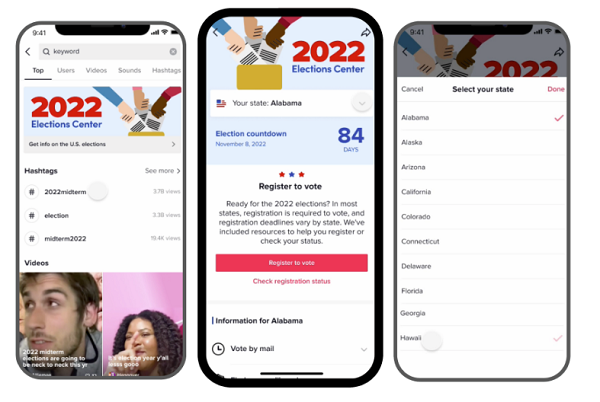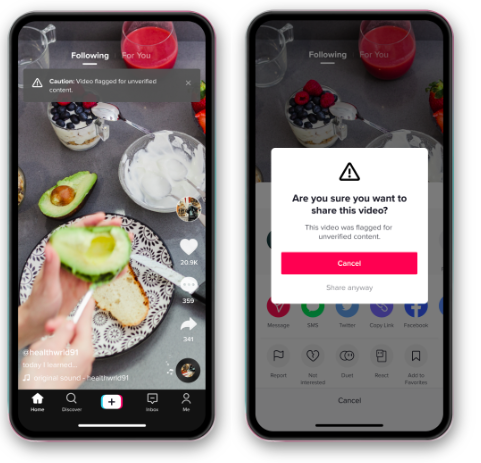With the US midterms coming up, every major social network is working to get ahead of an expected rush of misinformation, division, angst and hate, with each app deploying a range of new tactics and tools to better detect concerns, and clarify official updates.
Which, this time around, also includes TikTok, which now has a hugely influential presence in the US.
Today, TikTok has outlined its election security measures, including a new Election Center to host official updates and information, new labels on candidate accounts, and updated guidance on political ads and endorsements.
First off, TikTok’s rolling out an updated Election Center to help provide trusted information on the polling process.

As per TikTok:
“Providing access to authoritative information is an important part of our overall strategy to counter election misinformation. That’s why we’re rolling out an Elections Center to connect people who engage with election content to authoritative information and sources in more than 45 languages, including English and Spanish.”
As you can see in these example screens, TikTok’s Election Center will provide information on how to vote in your region, while it will also include additional voting information resources for people in special categories, including deaf voters, overseas citizens, service members, etc.
All of this information will be sourced from official providers to help maximize voter participation.
TikTok’s Election Center will also keep track of official poll results as they come in, providing another means to help alleviate misinformation.
Which has become a major concern in the US. Last year, a ‘far right Twitter troll’ was charged with spreading disinformation online that tricked almost 5,000 Democratic voters into casting their ballots by phone, instead of going to the polls. This is just one example of the lengths that political supporters have gone to in an effort to limit civic participation, in the hopes that this will improve their chosen candidates’ potential of winning.
As such, simple prompts and official reminders like the Election Center can serve an important purpose in providing official information, at scale, in the apps and tools that people are already familiar with (and in the case of TikTok, spending all of their free time using).
In addition to this, TikTok’s also adding new labels to content that’s been identified as relating to the 2022 midterm elections, as well as all content from accounts belonging to governments, politicians, and political parties in the US.
“These labels will allow viewers to click through to our center and get information about the elections in their state. We’ll also provide access on popular elections hashtags, like #elections2022 and #midtermelections, so that anyone searching for that content will be able to easily access the center.”
TikTok has also underlined its fact-checking efforts, with the platform collaborating with accredited fact-checking organizations across 30 languages, in order to enforce its rules around misinformation and false reports.
That includes labels on questioned posts.
“Out of an abundance of caution, while content is being fact checked or when content can’t be substantiated through fact-checking, it becomes ineligible for recommendation into For You feeds. We also inform viewers of unsubstantiated content and prompt them to reconsider before sharing potential misleading information.”

Small prompts like this can have a big impact, with Twitter reporting that its similar alerts potentially offensive tweet replies lead to a 30% reduction in negative interactions as a result.
TikTok finally notes that it doesn’t allow paid political ads, and that it has strict rules in place for paid collaborations with influencers.
“We work to educate creators about the responsibilities they have to abide by our Community Guidelines and Advertising policies as well as FTC guidelines. Over the next few weeks we’ll publish a series of educational content on our Creator Portal and TikTok, and host briefings with creators and agencies so the rules of the road are abundantly clear when it comes to paid content around elections. If we discover political content was paid for and not properly disclosed, it is promptly removed from the platform.”
As noted, whether you like it or not – whether you personally use it or not – TikTok has become a hugely influential platform, with hundreds of millions of Americans now engaging with TikTok clips every day, which inevitably means that it will also be a target for political campaigners looking to influence voters, and swing the results in their favor. As such, it’s important that TikTok does make an effort to combat election misinformation, and to keep its users informed where it can – while we’ve already seen the app become a target for various types of political misinformation campaigns around global events.
Indeed, earlier this year, TikTok has forced to take action against accounts posting fake videos from Ukraine, which purported to depict scenes from the Russian invasion, while the platform has also been questioned over alleged censorship of anti-China sentiment, and potentially working with the CCP to seed more positive stories about the Chinese regime.
Definitive evidence on the latter has been difficult to pin down, due to variances in algorithmic sorting, but as TikTok continues to grow, this will remain a key concern – because is it now a key platform for information sharing and news content dissemination.
Whether you like it or not, whether it should be trusted with such or not. Meta, too, has had to face the same, as a result of its massive audience reach, and while global political tensions remain high, you can bet that Chinese-owned TikTok will remain a keen focus for political analysts in this respect.



